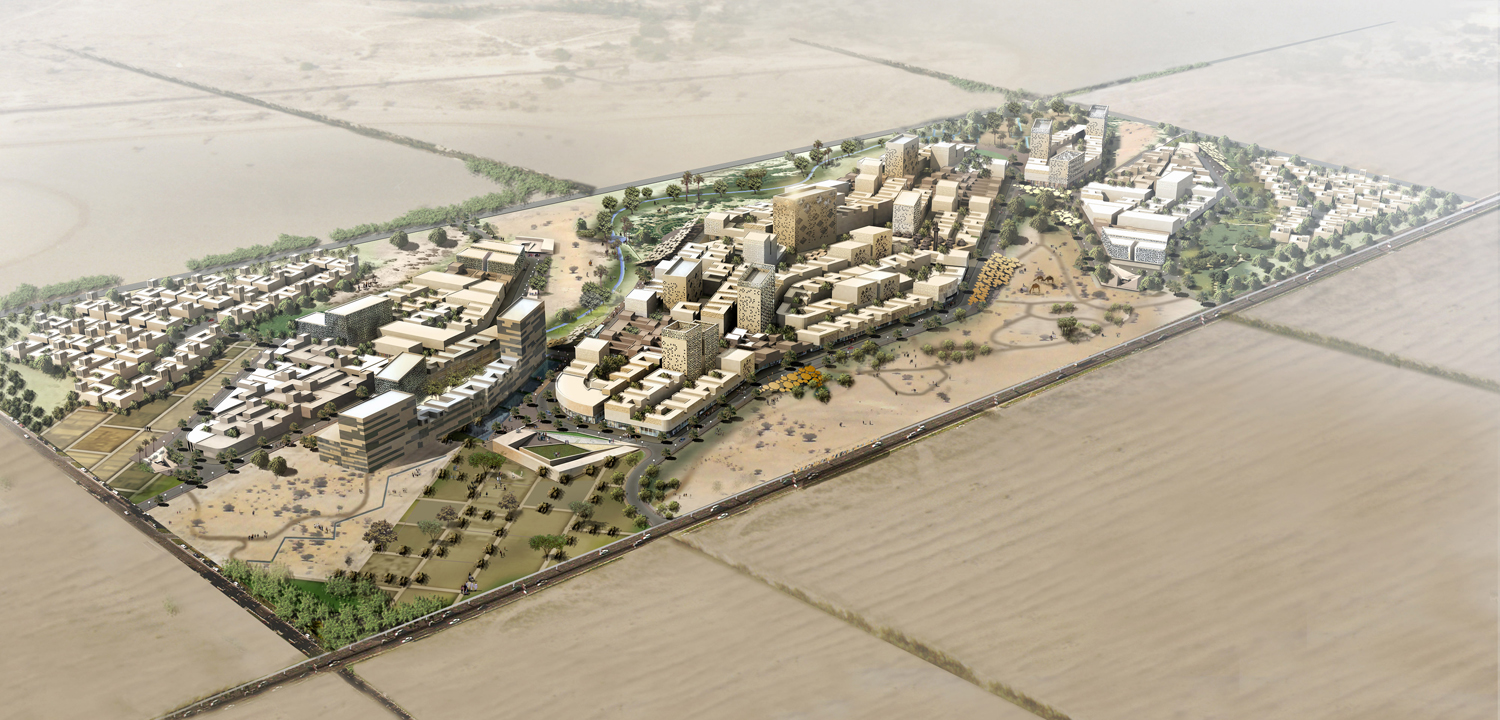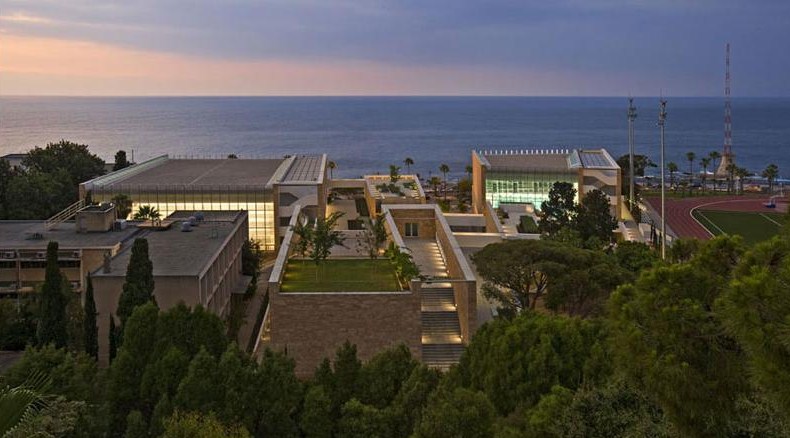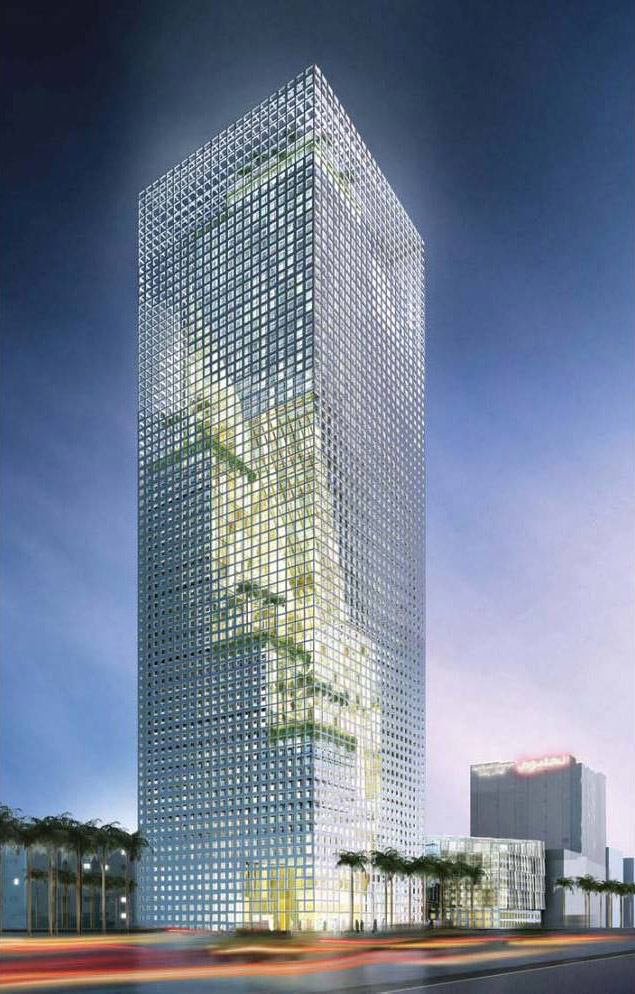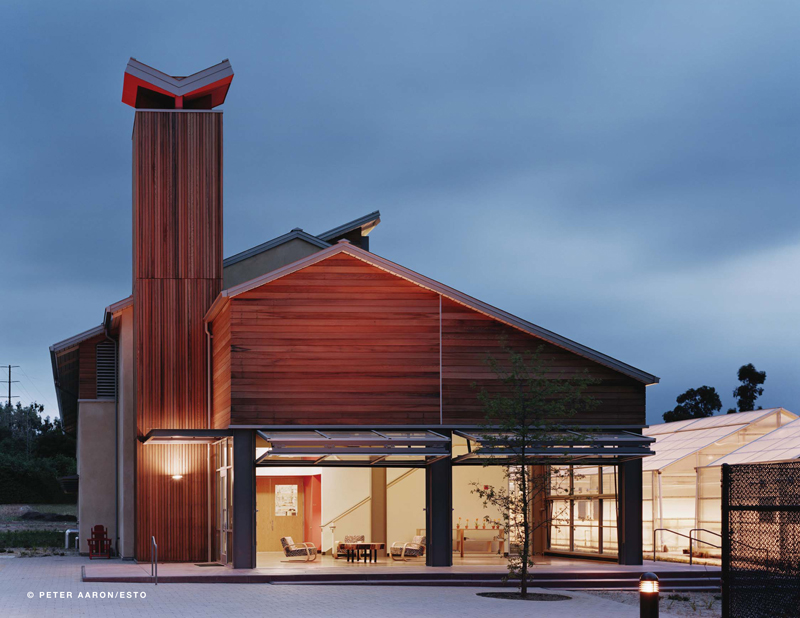|
|
Karim Elgendy
Throughout the last three decades, the city of Dubai has not been known for its emphasis on sustainability as guiding principles for its development. Not only did it adopt an unnatural rate of growth by middle eastern and global standards, it has also long disregarded the environmental and social consequences of its rapid urbanization. Dubai’s growth relied on -and was economically fueled by- a development model which imported inappropriate and inefficient building forms and planted them in its extreme climate. The result was a 1,500 square miles city (3,885 square kilometers) with isolated island buildings that are not only divorced from their environments, but which also require a great amount of fossil fuel energy to remain habitable.
 Image 1. Aerial View of Xeritown showing massing and landscaping. Copyrights: X-Architects and SMAQ The city of Dubai also has one of the highest carbon footprints per capita in the world, and even though this footprint is partially a result of energy intensive water desalination processes on which the city relies for its potable water, Dubai’s carbon footprint remains higher than that of other gulf cities including Saudi cities which also rely greatly on desalination.
In many ways, it is fair to argue that the Dubai’s model of development has been, in essence, the antithesis of sustainable development over the last three decades. In other words, Dubai has come to represent the climax of an obsolete development model in which humans attempted to subjugate their environment rather than coexist with it.
In contrast to this un-sustainable development pattern, Dubai’s neighboring city of Abu Dhabi has long adopted a measured and less extravagant development model. Over the same three decades, Abu Dhabi’s development model was generally characterized with a more sustainable pace of development. In the last few years, Abu Dhabi has been attempting to champion sustainable development in the Middle East by establishing a sustainability oriented framework for its development over the next 20 years, and by establishing the Masdar initiative which includes the world’s most progressive sustainable city project at its outskirts with ambitious zero-energy and zero-waste targets.
Continue reading Dubai Experiments with Sustainable Development
Karim Elgendy
In 2009, the American University in Beirut’s new student center was recognized as one of the American Institute of Architects’ Top Ten Green Buildings, the most prestigious profesional award for sustainability in the United States and one that is rarely awarded to international projects in the Middle East. The new student center is situated within the 73-acre campus of the American University in Beirut (AUB) and is named after Charles Hostler, the former US Ambassador and an AUB Alum. The student center is sited at the foot of a steep hill overlooking the Mediterranean sea and extends down to the Beirut Corniche, the capital’s grand waterfront boulevard (Image 1). The $30 million project was designed by the Minneapolis based VJAA together with the Lebanon based Samir Khairallah & Partners. The Stuttgart based Transsolar and the San Francisco based Hargreaves were part of the design team as environmental consultants, and Landscape designers, respectively.
 Image 1. View of Charles Hostler Student Center as seen from the Hill above. Copyrights: Paul Crosby Continue reading The American University in Beirut Combines Innovation and Traditional design
Karim Elgendy
In late 2008 the French President Francois Sarkozy inaugurated a new French school in Damascus, Syria. The French school, known as Lycée Charles de Gaulle, follows the french educational system and is accreddited by the French ministry of education. The school was designed by the French architects Ateliers Lion together with the German environmental engineering firm, Transsolar.
 Image 1. Night view of school central courtyard showing the solar chimneys. Copyrights: Adria Goula Sarda, Ateliers Lion The brief for the design team was to to develop a campus for the school with a capacity for 900 students ranging from kindergarten to high school. The design team was also tasked to develop a campus that embodies sustainability by using low-technology solutions for ventilation and conditioning of the school spaces, while maintaining the thermal comfort levels required for students in an educational environment.
Continue reading A Damascus School Revives Traditional Cooling Techniques
Karim Elgendy
As previously reported on Carboun, Masdar City – the $22 billion project of the Abu Dhabi Future Energy Company (Masdar) – is currently under construction and is due to be completed in 2016. As the the first zero-carbon emissions and zero-waste city, the master plan for Masdar City integrates many passive design and planning strategies with renewable energy production to achieve its ambitious sustainability goals.
At the center of Masdar City lies its first building, the Masdar Headquarters, which will become the new home of Abu Dhabi’s Future Energy Company, as well as the secretariat of the International Renewable Energy Agency (IRENA). The building – together with other key building -will act as an anchor and a catalyst for the development of the city.
 Image 1. Rendering of Masdar HQ. Copyrights: Adrian Smith+ Gordon Gill
Continue reading Abu Dhabi’s Masdar Headquarters: The First Positive-Energy Building in the Middle East
 Image 1. A night view of the design showing the shading envelope and the spiraling forms behind. Copyrights: Perkins+Will In February 2010, the design for Al-Birr Foundation Headquarters in Riyadh, Saudi Arabia, has been named as the winner of the 2010 Architectural Review / MIPIM Future Projects Awards under the ‘tall buildings’ category (Image 1). The unbuilt project, designed by Perkins+Will’s New York Office, was commissioned for Al-Birr Foundation, a non-profit organization aimed at alleviating poverty and caring for disadvantaged families and children.
The Design
Of the many features of the design of the 59, 000 sqm tower, perhaps the most interesting is how it was concieved as a sustainable urban tower that responds to the environmental characteristics and the microclimate of the city of Riyadh, which is a challenging climate to address given the extreme solar exposure and the heat conditions of Riyadh.
Faced with these climatic conditions and a deep plot of 1000 x 1200m, the projects’s designers response was to rethink the high rise typology in this context. The design’s most visible response to the climate is the building’s envelope which was designed as a large rectangular frame of brise-soleil enclosing the occupied parts of the building. This shading frame was designed to respond to both the different amounts of solar radiation received by each elevation as well as the interior spaces behind it. To achieve this result, a mapped shading mesh was devised to provide varying levels of openness for different locations of the different elevations depending on its solar exposure and its spatial/contextual influences. The result was an envelope that resembles a mesh of varying densities surrounding the building and simultaneously protecting and revealing the activities behind it.
This proposed design solution thus helps the building reduce its solar heat gain while maintaining its views towards the city (FIgure 1). In addition to this shading effect, the mesh-like dynamic treatment of the envelope has also helped animate the building’s expression with the dense and sparse zones of the facade adding a dynamic effect to what otherwise may have become a static pure form.
Continue reading Riyadh Tower Design adapts a Traditional Middle Eastern Shading Strategy
Karim Elgendy
The Carnegie Center for Global Ecology in Stanford is a research facility that combines Laboratories and office spaces. The 1100 Sqm building was built on a previously developed plot of 7.4 acres. The client’s main concerns were lowering the carbon emissions tied to the building’s energy use as well as the embodied carbon emissions of building materials. Flexibility over the short and long term was also of utmost importance to the client who wanted to allow for the expansion and contraction of research teams.Like Many of the Climates of the Middle East, Stanford has an arid climate with a long dry summer season, and benefits from northwest breezes.
 Image 1. View of the Eastern facade of the Carnegie Center showing the wind tower and the naturally ventilated entrance lobby. Copyright: Peter Aaron / Esto
Karim Elgendy
Energy use in buildings accounts globally for nearly 40% of global energy consumption and 36% of total energy-related carbon dioxide emissions. These percentages are almost equally split in two halves between the industrialized countries and the rest of the world (Price et al., 2005).
Our buildings use energy in two ways; first, to keep our interior environment comfortable through cooling, ventilation, and heating our spaces; second, to power the appliances that we have come to depend on such as home appliances, lighting systems,computers, and other office equipments. To reduce this high percentage of energy use and the resultant carbon dioxide emissions, both sources of energy use in buildings must be addressed. The first energy use can be addressed by improving the building envelope’s efficiency in order to reduce the need to condition its spaces (cooling, heating, and ventilating). This method of conserving energy use includes a vast array of passive low energy design strategies that depend on the building’s environment and context. The second energy use can be addressed by improving the efficiency of appliances and equipment used inside buildings including improving the efficiency of lighting and dissemination of improved stoves for cooking in rural areas. Continue reading The State of Energy Efficiency Policies in Middle East Buildings
|
|






